#morphological processes
Text
How does one compare and contrast morphological processes across different languages?
Morphology is the branch of linguistics that studies the internal structure of words and how they are formed. Morphological processes differ across different languages, and understanding these differences can help in language acquisition, translation, and language preservation efforts. In this article, we will discuss how one can compare and contrast morphological processes across different…

View On WordPress
#affixation#agglutination#comparative morphology#derivation#fusion#inflection#isolating#morphological processes#Morphology#morphology in different languages#polysynthetic#reduplication#root#stem#Suppletion#typological analysis
0 notes
Text
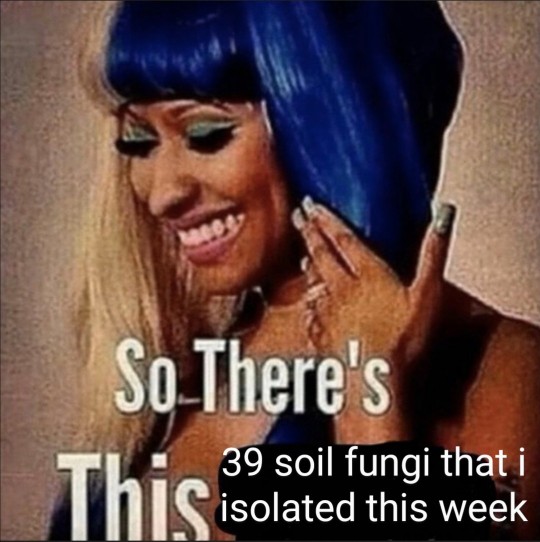
#ok to be fair there were only 2 distinct morphologies‚ at most 3 lol#but we'll see........👀#in the process of purifying#hopefully ill get some yeasts or slower growing molds in a couple weeks <3
5 notes
·
View notes
Text
Saturday Writing Sprints
I am in a writing crunch with the hope of turning in this chapter by Sunday night. I've got a zombied together smattering of text and a full outline. I'm going to do 30 min sprints with breaks all throughout the day and will update about my progress. If you need the motivation to do the thing, do it with me!
I'll be working with the overall outline as my macro to-do list. Then I'll break it down into 30 min plans and go! I'll be using Google Timer to visualize the time passing since I have time blindness something AWFUL lol
Chapter Outline
Introduction
Lessons from the Planar Fractal Method
The Need for Independent Criteria: Tri-P Mapping
Reanalysis
4.1 Cup'ik
4.2 Mazatec
Discussion
Conclusion and Future Directions
____________
Session 1 [5 min plan, 30 min session, 5 min report back]
Plan: Work on the Introduction, get a good feel for the plan and flow
Report: I've been working on my summary table of all the chapters, and hyperfocus has hit! Onto the next session
____________
Session 2 [5 min plan, 30 min session, 5 min report back]
Plan: Continue work on overall summary of results
Report:
#studyblr#academia#professional academic#academic writing#writing sprints#pomodoro sprints#writing process#linguistics#morphology#phonology#syntax#wordhood
2 notes
·
View notes
Text
youtube
I have started putting my (almost) entire drawing process up on my second channel! It is sped up to 300% and has music in the background, feel free to study or draw along!
#draw along#to study to#to draw to#drawing process#terminid#helldivers 2#fanart#fan art#morphology#stalker#helldive#enjoy#Youtube
1 note
·
View note
Text
help I've anthropomorphized morphology
#a grammatical morpheme is like work clothing!#(turning examples of linguistic processes into metaphors helps me not be distracted by the content in the example itself which is#often in a language I don't speak)#so when you add a funky little '-s' to 'book' it's putting on a hat#so it can go do its job in the 'plural' department!#some words have more clothes on than others or different ones#not all morphemes are grammatical#sometimes people wear clothes that are show identity!#'booklets' works in the plural department but it's also wearing a little scarf (-let) because it likes to show off how small it is!#(my roommate has guests over and I'm too shy to go fix myself food while they're all there please humor me)#obviously this is very very basic morphology but I have developed a universe okay? (see my previous og post)#they have VIRUSES#and weird DNA development#harmless fabric allergies#look it's a long story#but the issue with linguistic examples is that it's very hard to find isolated ones#because most of the time several things are happening at once (this applies to more than just morphology)#which can be distracting sometimes because you're not sure where to look#look this makes sense to me#morphemes are work clothes#well I guess except for the one morpheme that all the pants and hats and socks hang on to for dear life#look my metaphor isn't perfect#BUT#I had fun procrastinating my other studies while coming up with it
0 notes
Text
#When faced with the reality that the failure to get pregnant is an issue that requires IVF or Test tube Baby treatment#the first concern is the cost of IVF. Patients take pains to locate the providers of 'the most affordable IVF treatment'#'cheap cost IVF treatment'#etc#not realizing that it is not IVF cycles that is the concern. They should be searching for the provider of 'the least cost to pregnancy'.#Which is actually more important#than the cost of a single IVF cycle.#In this video we will be addressing the different ways by which the fertilization can be achieved and how they are different from each othe#In ICF or Test tube baby process the sperms and the eggs are retrieved from the male and female partner respectively and made to fuse in a#Another procedure which is often been performed is ICSI#that is intracytoplasmic sperm injection. This procedure is very helpful in case of#any sperm motility issue. What we do in this procedure#is injecting the sperm directly over the egg that will ensure the fusion and embryo will be formed.#Going one more step ahead#is the discovery of IMSI#that is intracytoplasmic morphologically selected sperm injection. in this the sperm which is of a good quality is selected and made to fus#is transferred to uterus.#We may have a good fertilization rate or good success with ICSI#but sometimes the quality of the sperm makes lot of difference.#To overcome this challenge the IMSI#is a improved technology which came into existence#which has a good fertilization chances.#When the success rate is high#the number of cycles to achieve the same are less so the cost of such cycles are also less.#There are many cases#where the ICSI or IMSI can yield the positive results#when there is a problem or issue with the sperm motility or morphology.#Since it's a complex procedure#there are many components which affect the cost of healthy pregnancy.#We will see in detail about D3 ot D5 embryo transfer and success rate.
0 notes
Text
#Processes In Evolution#genotype (genetics) and phenotype (morphological)#apctgroup#apctnews#latest news
0 notes
Text
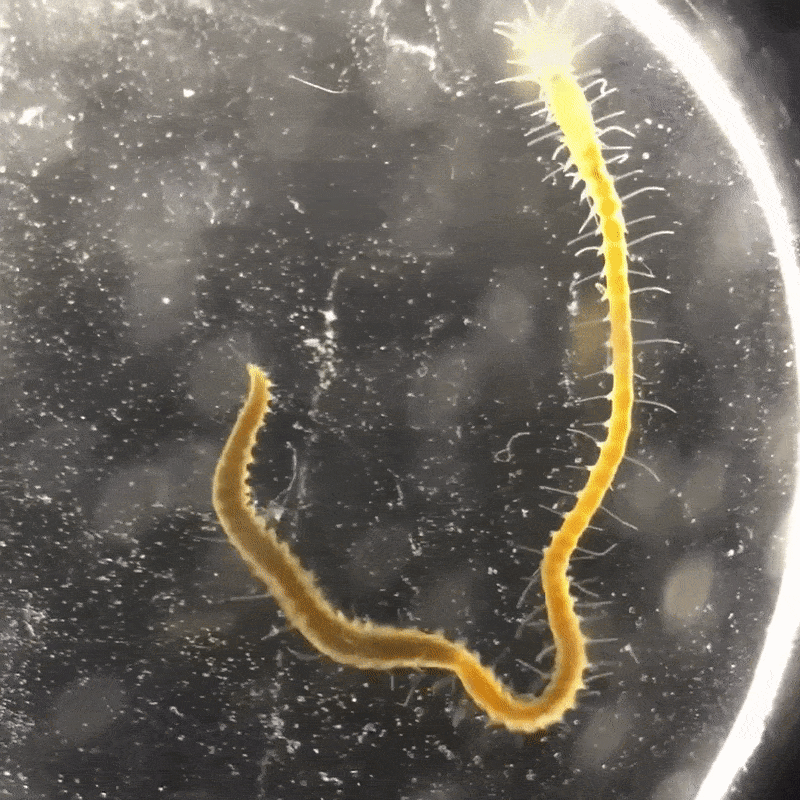
The Japanese green syllid Megasyllis nipponica, is a bristle worm native from the coast of Japan, but now is know to live in coastal parts of California where is stablished. This little dance seen in the GIF have a reproductive reason, and researchers now explaing better what is happening, and you may not be prepared to this.
The brown and dancing body segment is called the stolon, which detaches from the worm in a unique reproductive process called stolonisation or schizogamy. When gonads are matured, the stolon developed a head, which even posses eyes, antennae and bristles, then the stolon can break off and swim away, to break apart to release eggs or sperm. This bizarre process continues before the stolon detaches when it develops nerves and a ‘brain’, allowing it to swim independently from the original body.


Video and figure by Nakamura et al 2023
Reference (Open Access): Nakamura et al. 2023 Morphological, histological and gene-expression analyses on stolonization in the Japanese Green Syllid, Megasyllis nipponica (Annelida, Syllidae). Sci Rep
#Megasyllis nipponica#Megasyllis#syllidae#stolonisation#stolon#schizogamy#science#reproduction#biology#marine biology
404 notes
·
View notes
Text
Ok I'm going to redo that linguistics poll that I accidentally only made last a day
1K notes
·
View notes
Text
"black cat girls" "golden retriever boys" what about us cotylorhynchus girls?

Cotylorhynchus is an extinct genus of herbivorous caseid synapsids that lived during the late Lower Permian (Kungurian) and possibly the early Middle Permian (Roadian) in what is now Texas and Oklahoma in the United States. The large number of specimens found make it the best-known caseid. Like all large herbivorous caseids, Cotylorhynchus had a short snout sloping forward and very large external nares. The head was very small compared to the size of the body. The latter was massive, barrel-shaped, and ended with a long tail. The limbs were short and robust. The hands and feet had short, broad fingers with powerful claws. The barrel-shaped body must have housed large intestines, suggesting that the animal had to feed on a large quantity of plants of low nutritional value. Caseids are generally considered to be terrestrial, though a semi-aquatic lifestyle has been proposed by some authors. The skull of Cotylorhynchus shows the typical caseid morphology with a forward sloping snout, very large nasal opening, a skull roof with numerous small depressions, and a very large pineal foramen. The latter is wider than long as in Ennatosaurus and thus differs from that of Euromycter which is subcircular.[2] The number of teeth in the upper and lower jaws ranges from 16 to 20. In the upper jaw, the anterior teeth are long and slender, while those behind decrease in size posteriorly and are slightly spatulate. All the marginal teeth have their distal end slightly inclined towards the interior of the mouth and the top of their crown each have three small cuspules arranged longitudinally. These teeth also show an enlargement of the central part of the crown.[3] In the lower jaw, the anterior teeth, not denticulate according to Olson, are shorter and tilt slightly forward. Other lower teeth are similar to those in the upper jaw. The postcranial skeleton is massive. The ribs are very long, heavy and curved to form a bulbous body. Ribs are present on all the pre-sacral vertebrae and the first caudal vertebrae. The five posterior presacral ribs are fused with the transverse processes of the vertebrae. The sacrum contains three vertebrae. The neural spines of larger specimens become proportionately taller, especially in the pelvic region. The limbs are short and strong. The femur is characterized by its proximal end having a broad shelf marked by a margin slightly overhanging the dorsal surface of the femur. The pes and manus are broad and short, and terminate in strong, sharp, and curved ungual phalanges which must have supported powerful claws. Muscle and tendon scars are very developed.[3]The genus Cotylorhynchus is represented by three species, the largest of which could reach more than 6 m in length. However, a study published in 2022 suggests that the genus may be paraphyletic, with two of the three species possibly belonging to separate genera. The genus name Cotylorhynchus comes from the Greek kotyle, cup, hollow, and rhynchos, beak, or snout. The genus was named so because of the nasal opening which is surrounded by a depressed, cup-shaped bony surface.[1] The genus Cotylorhynchus contains three species which differ in size and proportion, C. romeri (the type species), C. hancocki, and C. bransoni. In C. romeri there are two size groups which presumably represent sexual dimorphism. There is no size overlap between adults of C. romeri and C. hancocki, but larger specimens of C. bransoni have roughly the same dimensions as smaller specimens of C. romeri.[3] In 2022, Werneburg and colleagues suggested that the species C. hancocki and C. bransoni might not belong to the genus Cotylorhynchus. These authors consider that a detailed revision of these two taxa is necessary to clarify their status.[4]
187 notes
·
View notes
Text
MER WIND!!!!!
(boxing peacock lobster)
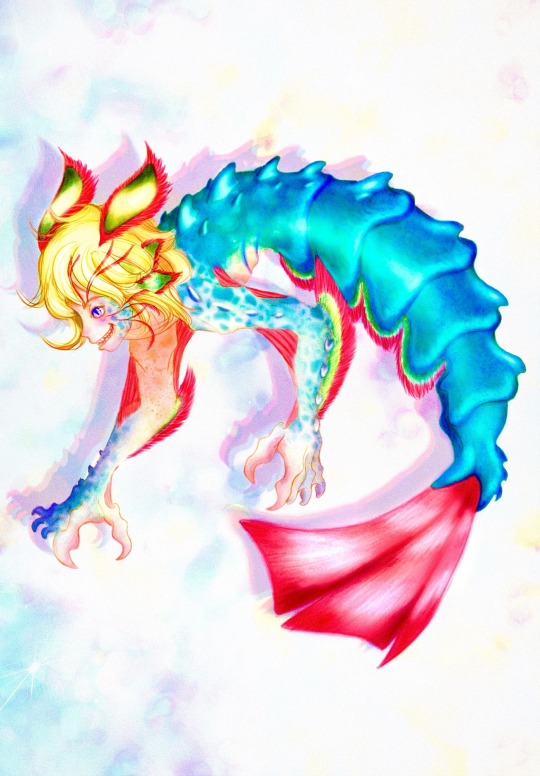
Click to see the chain: Time // Twi // Wars // Sky // Hyrule // Legend // Wild // Wind // Four
Click to see the Mers!: Time // Twi // Wars // Sky // Hyrule // Legend // Wild // Wind // Four
🦞More details🦞
Eyes
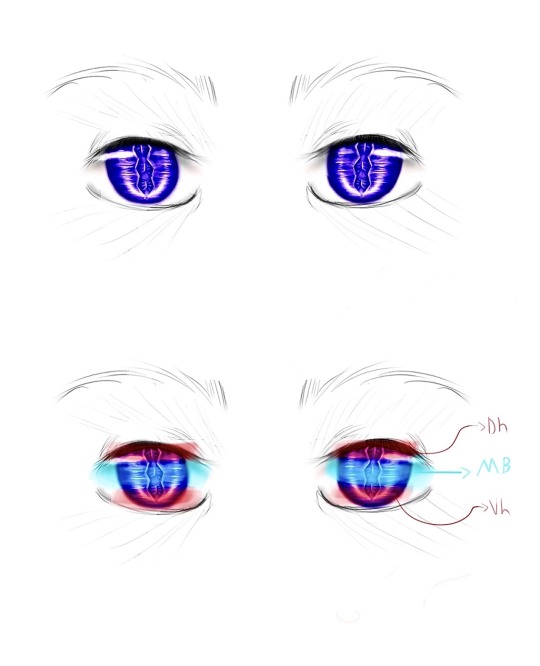
These little guys are the holder of the most complex vision on the animal kingdom! Oh boy, I spend a good time studying about it lol
- He has hexocular vision (each eye having 3 iris and moving independently)
- Wind's eyes are divided into three morphological sections: midband, dorsal hemisphere and ventral hemisphere.
*The Dh and Vh sections have sensitivity to 4 types of polarized light ( 2 diagonals, horizontal and vertical ) which allows a better analysis of the environment in therms of dimensions, perspective, distance, composition... (in other words , he can almost feel the world with his eyes. He uses this to find weak points in his opponents )
*MB is divided into 6 sessions that have 16 types of photoreceptor cells and cells sensitive to circular light polarization (which allows him to see ultraviolet and infrared)
-The image is processed by the eyes instead of his brain, which allows faster reactions
- Wind possesses selective vision, being able to change the "setting" of his eyes in a blink

Human eyesight:
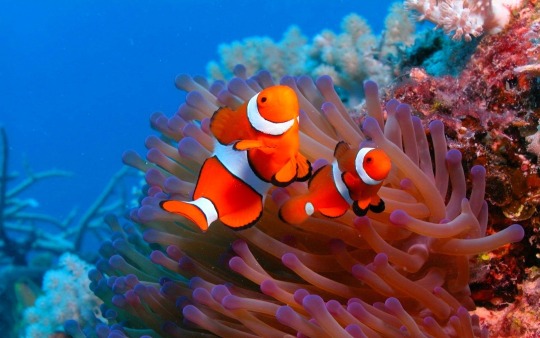
~~~🦞🦞🦞~~~
Antennae
- The "feathers" on his head reflect different polarizing and fluorescent patterns that he uses for communication, and in some cases, intimidation

~~🦞🦞~~
Raptorial armppendage
- Wind's "punches" are as powerful as a 22 calibre gun. Due to the rapid strike, it causes a cavitation bubble generating a second impact ( his claws accelerates 104 km/s in 2.7ms and the bubble generated by the impact can reach temperatures of 4400C which is nearly the temperature of the sun )

~~🦞🦞~~
Body
- He has a very dynamic swimming style and can swim backwards, head downs and even "walk"

Weight : 42 kg (92,6Ib)
Length : 1,64m (5'4ft)
#gatto art#linkeduniverse#linked universe#linked universe au#lu#lu au#h2o au#lu wind#linked universe wind#mer!wind#mer!au#lobster#lobster mermaid#kinda#beside the name they aren't lobsters#or shrimps#I have a new favorite now#it was so fun drawing that#these lil fellas are awesome
63 notes
·
View notes
Text
How does one use computational methods to analyze and process morphologically complex words in a language?
Computational methods have become increasingly important in the field of linguistics, particularly in the study of morphologically complex languages. These methods allow linguists to analyze and process large amounts of data in a way that would be impossible using traditional methods. In this article, we will explore how computational methods can be used to analyze and process morphologically…

View On WordPress
#computational linguistics#deep learning#finite-state transducers#machine learning#morphological analysis#morphological segmentation#morphological tagging#Morphology#natural language processing#neural networks
0 notes
Note
Is there anything that poison types can't eat? Like I know that I have to keep my skitty away from my garlic bread by any means necessary because garlic Will Kill Her, and I know that steel types are immune to poison and would probably be fine eating fucking hemlock, but I'm curious about poison types themselves. Is there anything I should keep them away from at all costs?
it depends on the poison type. some poison types have become generalized eaters because their "poison" is really just an intense bacterial load. grimer and trubbish both fall into this category, and they can eat a very wide variety of things that would be toxic to most other pokemon. but many poison types have specific diets they need to follow, because their poison comes from other sources such as the protein-based venom of ekans. it's absolutely possible to make an ekans very sick by feeding it food it can't process, like large amounts of berries or vegetables.
as always, although typing is important, it's generally less of a factor in care than a pokemon's morphology. what food you need to keep away from a poison type is going to depend on what specific pokemon you're handling.
62 notes
·
View notes
Text
The study of potential belic instruments is never ending...




107 notes
·
View notes
Text
I think linguistics has a huge methodological problem, in that while there exist some formalised methodologies for conducting investigations, it's clear that you don't have to pursue any of them to actually get ahead academically because linguists aren't actually as scientifically rigorous as they would like to think.
This has knock-on effects for more general experimental design, because it is extremely common to find studies which purport to prove/disprove some hypothesis, but when you actually look at the methodology they use you find that it doesn't actually provide evidence for the point they're attempting to make.
Of course the most common place to find this kind of stuff is in the Generativist literature, which is awash with claims the phenomena they describe is only explainable through the assumption of Universal Grammar/a Language Organ/whatever, when in fact non-innatist models work just as well. But this isn't the only part of the field that is susceptible to this.
So for instance there was a paper put out in Science recently that claims to have found evidence to counteract the idea that social structure can have an impact on the structure of the language (most notably explicated by Peter Trudgill in his 2011 book Sociolinguistic Typology, give it a read if you can find it). They take demographic data from Ethnologue and compares this with a couple of metrics which supposedly quantify linguistic complexity.
Leaving aside the (sometimes glaring) issues with the way the metrics are defined (they perhaps could have done with reading Dahl 2004 The Growth and Maintenance of Linguistic Complexity), we can already spot a major problem with using these correlations to make claims regarding the Sociolinguistic Typology hypothesis: the phenomena in question are explicitly diachronic in nature, but the data being used to assess them is solely synchronic.
What do I mean by this? It's been suggested that English morphology is less complex relative to e.g. German because of contact with the large numbers of Old Norse speakers that settled in the Danelaw. The trouble is, of course, that all those Norse speakers later shifted to English, so this large community of L2 learners won't show up in the data, despite the effects still being apparent after over 1000 years. Similar points can be made about most of the languages where these kinds of effects have been proposed: it was precisely the process of these languages spreading rapidly and acquiring a large speakerbase in a disorganised fashion that cause these changes to occur. Indeed, the authors specifically note that education and official language status are factors that would mitigate against the failures of L2 transmission that are claimed to cause these simplification effects, but don't then seem to acknowledge that this is a major issue for extrapolating the correlations anywhere further back than the 19th Century.
I think there are several things going on here which have led to this kind of thing being possible. Firstly, linguistics has always had an uneasy continuing relationship with the rest of the humanities and parts of the sciences (particularly neurobiology and acoustics), because it touches on so many of them at once. Secondly, and relatedly, we've had a fairly significant period where the core theoretical concerns of linguistics were essentially driven by a philosopher (Chomsky), which created a model of research that explicitly rejected empirical work and argued for much of its base assumptions (such as 'Poverty of the Stimulus') almost entirely by thought experiment. Empirically minded subfields continued to exist (Trudgill for instance made his career as a sociolinguist), but empiricism has been slow to make a return to theoretical linguistics. As a result, it seems to me that, at least in typology, people are still getting to grips with the idea of formulating hypotheses and actually working out tests that actually assess those hypotheses. Thirdly, because again of Chomsky, linguistics has had a strongly mathematical character in terms of its conception of language, and this again still lingers in the design of these kinds of studies. Everything has to be quantified in such a way that a simple computer model can work with it, but the trouble is there's frequently little room for the nuances of individual languages (e.g. Irish and Welsh are both counted on WALS as having the same value for inflection on adpositions, but actually a detailed study of the two languages reveals their systems work really quite differently, as I'll perhaps post on another time) which can therefore have knock-on effects for the analysis of any correlations thus derived.
104 notes
·
View notes
Text
Kalthifrons and the Fall of Mekosuchines
The penultimate singular mekosuchine I'll talk about here is Kalthifrons, one of the more obscure members of this clade. After all, Kalthifrons was named only in 2017 and unlike some other animals like Ultrastenos, it does not stand out as much morphologically. But I still wanna take a moment to talk about this medium-sized Pliocene croc, its potential fate and the implications for its relatives.
Left: The skull of Kalthifrons (Ristevski et al. 2023)
Right: A reconstruction of how the skull may have looked like intact


In many respects Kalthifrons looks very typical for a crocodilian, with a triangular head, rounded snout and eyes that face upwards. There are some interesting factors to mention, at least imo, and one thing thats sorta unknown. Starting with the unknown, what we aren't sure about is how deep the skull is. Sure the skull of Kalthifrons looks very intact in top view, but when looking at it from the side its about as flat as a sheet of paper. So we can't exactly tell how deep the skull would be. Maybe it was not much different from a modern croc...or maybe it was comparable to Baru the cleaver-headed crocodile. We simply don't know. The other two interesting things about its anatomy are more subtle. For one, the tip of the snout is comparably narrow. Now generally, if you look at mekosuchines the premaxilla and external nares tend to be wider than long, even in Australosuchus, but in Kalthifrons they are longer than wide. And then there's the frontal. The name Kalthifrons derives from the Latin word for forehead and the Dieri word for spear. The reason why is that the frontal bone, which covers the forehead, has an exceptionally long spear-like process at the front. Sure such a process is also found in other crocs, but in Kalthifrons it makes up 64% of this bones entire length.
A hypothetical reconstruction showing the size of Kalthifrons, which may have been around 3.4 meters.

With a length of possibly up to 3.4 meters and a triangular skull, Kalthifrons was probably a fairly generalist hunter. Fossils of Kalthifrons are known from a single place, the Golden Fleece Locality along the shores of Lake Palankarinna in the Lake Eyre basin, South Australia. Now this locality primarily yields two things. Croc fossils and turtles. Based on this and certain minerals in the sands of this locality, it has been suggested that the Golden Fleece Locality once housed a waterhole that dried up, leading to the deaths of its inhabitants.
The death of Kalthifrons as illustrated by Joschua Knüppe.
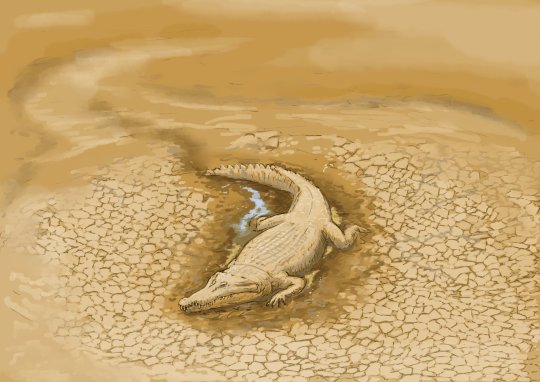
Which leads us to a bit of discussion regarding the general state of mekosuchines during the time of Kalthifrons. Now if you have read my previous posts on mekosuchines, you'll notice one thing. Most species native to continental Australia were around during the Oligocene to Miocene. Australosuchus, Baru, Ultrastenos, "Baru" huberi, Trilophosuchus and the continental Mekosuchus species. After the Miocene, continental species become rarer. Really you got Paludirex, Kalthifrons and Quinkana. And even they wouldn't stick around for much longer, with the last mekosuchines of Australia going extinct at the end of the Pleistocene.
So obviously mekosuchines experienced a drastic fall in diversity towards the end of the Miocene, clinging on for a few more million years before disappearing forever. But there's another thing that happened around this time. Modern crocodiles showed up. Contrary to popular belief, today's crocodiles of Australia are relatively recent arrivals. Freshwater crocodiles only lived there since the Pleistocene and saltwater crocodiles were likely even more recent, with both of them having evolved from different ancestors and arrived in Australia independently. But there's at least one more species of Crocodylus. The as of yet unnamed Tirari Desert Crocodile is known from remains that date to strata slightly more recent than that of Kalthifrons, displaying similar generalized anatomy. Like freshies and salties, the Tirari Crocodile arrived on its own, with phylogenetics indicating that its closest relatives were the palaeoafrican crocodiles like Crocodylus thorbjarnarsoni (a giant that grew up to 8 meters long).
Crocodylus species of Australia
Top left: The freshwater crocodile (Ristevski et al. 2023)
Bottom left: The saltwater crocodile (Ristevski et al. 2023)
Right: Stratigraphy of the Lake Eyre Basin and successions of local crocodilians (Yates and Pledge 2017)

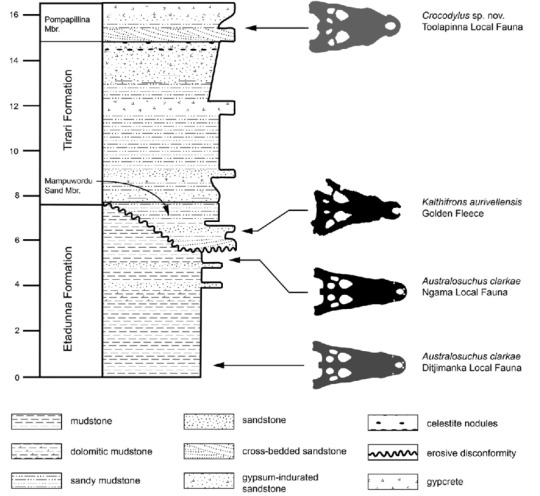
Did Crocodylus drive Kalthifrons to extinction? Well, maybe? Yates and Pledge discuss this possibility in the description of Kalthifrons, suggesting that theres some supporting pieces of information for this hypothesis. Not only does the arrival of the Tirari crocodile match up nicely with the disappearance of Kalthifrons, but they both share very similar anatomy. And conventional wisdom suggests that two crocs of the same morphotype don't really coexist in the same habitats.
But there's also points against that which aren't as openly discussed. Namely, the lack of material. Sure we have Kalthifrons in the older Mampuwordu Sand Member and the Tirari Crocodile in the younger Pompapillina Member, but remember. We only have that one Kalthifrons individual. We further know little about their habitat preferences. Sure conventional wisdom suggests crocs with similar morphology don't coexist, but that doesn't mean they don't overlap. Some species may very well be separated by the specific habitat they prefer. Slow open water, fast moving streams. Finally, is replacement necessarily the only answer? Not really. It has been deduced that Kalthifrons died in a drought and aridification is regarded as one of the main drivers of Australian megafauna extinction, as touched on in my summary of Paludirex. Maybe that's it? Kalthifrons was driven to extinction when environmental conditions grew too harsh, with Crocodylus entering the newly opened niche. This may parallel what happened in Miocene Africa, when rainforests disappeared osteolaemine crocodiles likely gave way to Crocodylus, which was better suited to the dryer climate.
Whatever the case, Kalthifrons is one of the most recent mainland mekosuchines and thus may be critical for us to determine what happened during this part of Australia's history. So sure it might not be flashy, but it's still an important little guy.
#mekosuchinae#kalthifrons#palaeoblr#prehistory#paleontology#pliocene#australia#croc#crocodilia#extinct#extinction#long post
90 notes
·
View notes